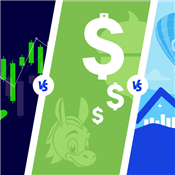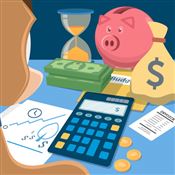How to Invest $20 Wisely
Ad Disclosure: This article contains references to products from our partners. We may receive compensation if you apply or shop through links in our content. You help support CreditDonkey by using our links.
$20 may not seem like much money. But there are many investment options open to you, from stocks to real estate. Find out how to start investing with only $20.
 |
| © CreditDonkey |
Only got $20 in your pocket? This may seem like just a few coffees or a dinner. But instead, you can invest it and grow that $20 in something more.
You may think that with such little money, you're only limited to penny stocks. That could not be further from the truth.
Nowadays, there are tons of investing apps that allow you to invest with tiny, micro amounts. Not only can you invest in the stock market, you also have a full range of other options, from bonds to properties.
Read on for the best ways to invest that $20.
Or simply get started using a micro investing app:
![]()
![]()
![]()
![]()
![]() Acorns (offers taxable and IRA accounts)
Acorns (offers taxable and IRA accounts)![]()
![]()
![]()
![]()
![]() Robinhood (offers taxable and IRA accounts)
Robinhood (offers taxable and IRA accounts)
10 Best Ways to Invest $20
 |
We all need to start somewhere. Keep reading to learn how to start investing in stocks, real estate, and more with just $20. Soon, you'll be on your way to building wealth.
How much is $20 worth? Enough to invest in real estate.With Fundrise, you can get into real estate with just $10. Click on your state to start investing in high-quality assets.
1. Purchase Real Estate
It may seem crazy to invest in real estate with just 20 bucks. But real estate crowdfunding lets you pool money with lots of other investors to fund properties together. You earn returns from the rents collected and when the property appreciates in value.
Real Estate Investment: Invest in Real Estate with $10+
- Only $10 minimum investment
- Get a diversified portfolio of real estate projects across the US
- Open to all investors
2. Auto Invest with a Robo-Advisor
Using a robo-advisor is the easiest way to start investing in the stock market for beginners. It's a good choice for investors who want to be completely hands-off.
Robo-advisors automatically invest your money for you, so you don't need any investment knowledge or experience. They create a custom, diversified portfolio based on your goals and risk tolerance and manage it for you. They also handle complicated tasks like portfolio rebalancing and tax saving strategies.
A lot of robo-advisor platforms don't have account minimums. So you're able to invest even with just $20.
Robo Advisor: $20 Investment Bonus
- Open an Acorns account (new users only)
- Set up the Recurring Investments feature
- Have your first investment be made successfully via the Recurring Investments feature
3. Buy Stocks with Fractional Shares
Yes, you can buy stocks with just $20. Thanks to discount brokers, the barrier to the stock market has never been so low. To buy individual stocks, you need to open an investment account with a self-directed brokerage.
When you only have a little bit of money to invest, make sure to look for a brokerage that supports fractional shares. This allows you to buy just a small fraction of a stock if you don't have enough for a full share.
With fractional shares, you can buy shares of stocks in any company you want, from Amazon to Apple to Netflix.
The good news is that almost all major brokerages have eliminated trade commissions for stocks. So you can now make trades for free.
Robinhood offers a popular discount brokerage account with commission-free trading. It has a very simple trading platform, so it's easy to get started for beginners. There is no minimum deposit and you can buy fractional shares starting with just $1.[1]
Stash is another micro-investing app that lets you invest small amounts. It provides stock recommendations in line with your goals. It also offers retirement accounts. However, Stash does have a small monthly fee starting at $3/month.[2]
4. Diversify Instantly with ETFs
Instead of investing in individual stocks, you can get instant diversification by investing in ETFs. An exchanged traded fund (ETF) is a basket containing hundreds of stocks.
An easy way is to invest in index funds, which track a specific market index. For example, the Vanguard S&P 500 ETF is invested in the 500 large cap U.S. stocks. So when you invest $20 into that, you're automatically investing in the 500 largest U.S. companies.
Brokerages that support fractional shares will also allow you to just buy a tiny amount of an ETF. On Robinhood, you can also invest in ETFs starting with as little as $1.
5. Invest in Mutual Funds
Similar to ETFs, a mutual fund is a professionally managed fund containing a collection of stocks and bonds. The main difference is that mutual funds are usually purchased in dollar amounts and trade just once a day at closing.
Usually, mutual funds have a higher minimum investment amount of $1,000 - $3,000. However, there are some with no minimums, so you can invest with just a small amount.
Fidelity, one of the most reputable mutual fund companies, offers a number of no-minimum mutual funds. Many even have 0% expense ratio, meaning there are no management fees, making them an incredible value.
6. Compound Your Earnings with DRIPS
DRIPS are dividend reinvestment plans. This is a program that allows you to buy stocks directly from the company (so you can bypass brokerage commissions). Many companies don't charge any fees to participate.
This is usually offered through companies that pay dividend distributions. When your shares pay a dividend, the company will automatically reinvest the dividends in shares. This helps your money grow faster with compounding interest.
A lot of companies let you invest in their DRIP program with as little as $25. If you continue to make regular purchases of $25 each month, it can grow into a nice sum of money when it's retirement time.
7. Invest in Worthy Bonds
Bonds are a type of debt investment. They are essentially loans to a company to help fund new operations. The company borrows money and agrees to make interest payments at a fixed interest rate over a set period of time.
The Worthy investing platform is the only platform that allows you to invest in bonds with as low as $10 in each bond. It guarantees a 7% fixed APY return. The bonds are used to offer loans to growing American businesses.
You can cash out your money at any time. There are no fees or penalties at all for buying bonds or withdrawing funds.
8. Open a High Yield Savings Account
Looking for something with no risk? A high yield savings account is a good place to park your savings and have them grow a little.
Online banks offer higher interest rates than traditional brick-and-mortar banks. A lot of them have no minimum opening deposit, account balance, or monthly service fees.
Another benefit is that your money is easily accessible any time you need it. Just note that federal regulations limit you to six withdrawals every statement cycle.
UFB Secure Savings - Earn up to 5.25% APY
- Earn up to 5.25% APY*
- No monthly maintenance fees
- No minimum deposit required to open an account
- Access your funds 24/7 with easy-to-use digital banking tools
9. Pay Off Debt
Becoming debt free first is the best kind of investment you can make for yourself on the road to financial security.
If you have debt, especially high-interest credit card debt, using $20 toward paying it off is better than putting it in an investment.
This is because the money you're paying on interest will wipe out any earnings from elsewhere.
For example, credit cards usually carry 13% - 20% interest (and that compounds every month you don't pay it off). It's unlikely you can earn that much return from investment options.
10. Optimize Your 401(k)
If you work for a company, chances are, you're contributing to a 401(k) retirement account. But do you really know what it's doing?
Most young people don't know that they have to actively manage their own 401(k) accounts. This means your 401(k) plan may not be allocated properly to your retirement goals. Your money may not be gaining as much as it could be.
Bonus: Invest in Yourself
And as a bonus, you can never go wrong with investing in yourself. If you can learn a new skill, that's a great stepping stone for second income opportunities or to improve your existing income.
Getting side jobs is not as hard to achieve as you may think. And if you are able to make some extra money on the side, that will help with your cash flow a great deal.
For example, invest your money in a Udemy course. Udemy offers hundreds of courses for under $20, from Photoshop training to digital marketing. Let's say you have an existing blog. If you're able to learn how to do better content marketing, that could increase your earnings tenfold.
Are You Ready to Invest?
Before you invest your money, consider if you have a stable enough personal finance situation. Here are some things experts recommend:
Have an emergency fund
If you don't yet have enough cash for 3 months' worth of expenses, then make that a priority. It's important to have money available in your bank account if there's an emergency expense or if you're out of work. A high yield savings account is perfect for your emergency savings.
Pay off consumer debt
As mentioned before, paying off debt is the best type of investment. Pay off credit card debt and personal loans before you start investing.
Have a budget
Just like budgeting for rent and food, it's important to budget money for investments too. Make sure to actively set aside $20 every month (or even more if you can!) for investments.
Bottom Line
You can invest no matter how much money you have. Even if you only have $20, that's a great start to get your feet wet in the world of investing. Today, even a little bit of money can get you access into the stock market or real estate investments.
Try out some of the options we mentioned, and soon, you'll have a well-rounded investment portfolio.
Invest in Real Estate with $10+
- Only $10 minimum investment
- Get a diversified portfolio of real estate projects across the US
- Open to all investors
The important thing is that you stay consistent. The reality is that you can't expect to only invest $20 once and become rich. Make investing small amounts a regular habit, and eventually, that will turn into a nice nest egg.
References
- ^ Robinhood. How to start investing for as little as 1 dollar, Retrieved 3/04/2024
- ^ Stash. Pricing, Retrieved 7/20/2023
- ^ Vanguard. Vanguard S&P 500 ETF, Retrieved 7/20/2023
Write to Anna G at feedback@creditdonkey.com. Follow us on Twitter and Facebook for our latest posts.
Note: This website is made possible through financial relationships with some of the products and services mentioned on this site. We may receive compensation if you shop through links in our content. You do not have to use our links, but you help support CreditDonkey if you do.
Fundrise, LLC ("Fundrise") compensates CreditDonkey Inc for new leads. CreditDonkey Inc is not an investment client of Fundrise.
| Expert Insights | A visitor from California read Real Estate Crowdfunding |
| Expert Insights | A visitor from Idaho read Best Online Savings Account |
| Expert Insights | A visitor from Michigan read Best Robo Advisor |
| Trending | A visitor from Oregon read Difference Between Stocks and Bonds |
| Must-Read | A visitor from Ohio read Robinhood Review |
|
|
| ||||||
|
|
|












